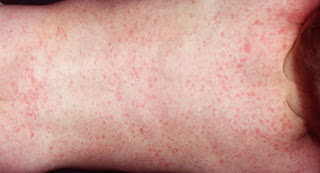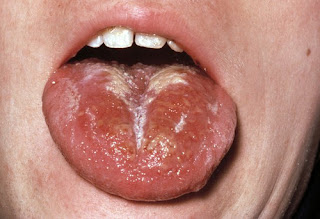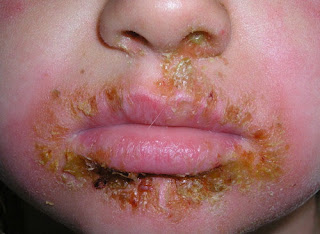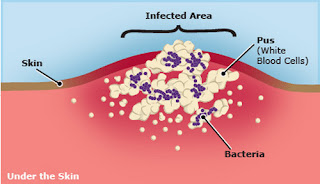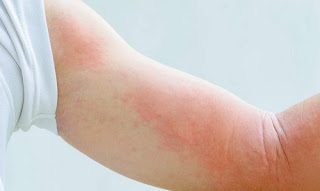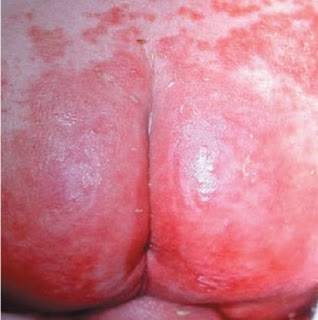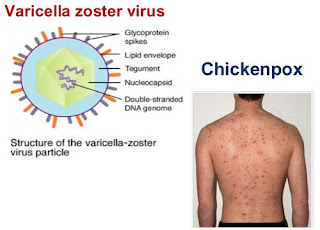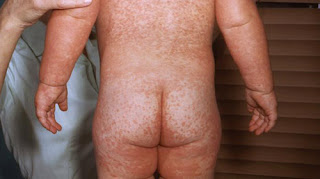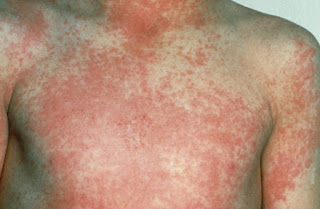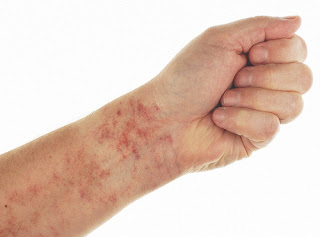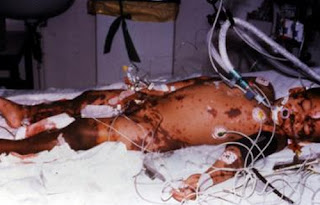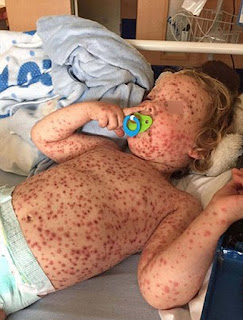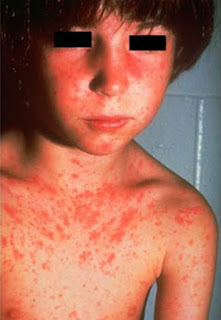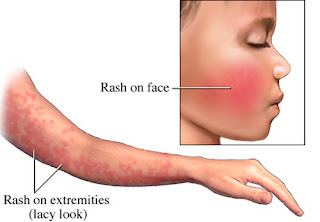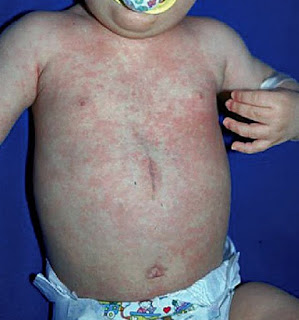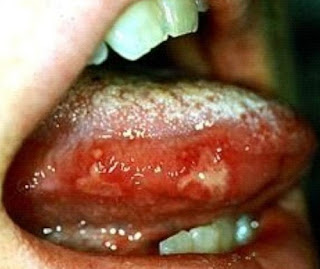Common Rashes in Children
A rash is the visual evidence that there is something going on inside. Rashes in children can be caused by an allergy, medication, bacteria, infection, or virus. A rash would tell an individual that something is irritating the skin.Virus Rashes in Children
- Chickenpox – this condition is caused by the virus varicella-zoster. Although the disease is not that harmful to most children, but the rashes will last up to two weeks or more, thereby causing too much discomfort to children.
Picture 1: chicken pox rash on the back of the child.
image source: www.nhsinform.scot
image source: www.nhsinform.scot
- Regular measles – this is caused by paramoxyvirus
Pictures 2: Regular measles on the obdomen caused due to paramoxyvirus
image source: wikimedia.org
- German measles – this is much milder compared to regular measles and is caused by rubivirus
Picture 3: Severe german measles on the chest of the child
image source: zyropathy.com
image source: zyropathy.com
- Fifth disease – this is also known as “slapped cheeks” disease and is caused by parvovirus B19. This viral infection commonly appears in the winter and spring seasons but may still infect someone throughout the year
Picture 4: rash on the cheeks look's like a Slapped Cheeks caused due to Fifth disease
image source: webmd.boots.com
image source: webmd.boots.com
- Roseola infantum - also called exanthem subitum, this is a common illness in children between 6 months and 2 years old which is caused by the human herpes virus 6.
Picture 5: Roseola infantum rash on the chest and stomach
Images source: babycenter.com
Images source: babycenter.com
- Coxsackieviruses – this is the most common cause of fever and rashes in children and two common diseases such as foot and mouth disease and herpangina
Pictures 6: Rash on the palms and sole due to Coxsackieviruses
image source: iytmed.com
image source: iytmed.com
Bacterial Rashes in Children
- Scarlet Fever – this is a strep throat infection with visible rashes. This throat infection is caused by group A Streptococcus pyogenes, and it commonly inflicts children of school age.
Piture 7: Severe rash on the tounge, infection caused by scarlet fever
image source: nhs.uk
image source: nhs.uk
- Impetigo – these are infection to the superficial skin caused by streptococcal or staphylococcal bacteria. The common areas affected are the nose and mouth but can also occur anywhere else in the body.
Picture 8: infection around the mouth and nose caused by impetigo
image source: doctorgrasshopper.wordpress.com
image source: doctorgrasshopper.wordpress.com
Picture 9: staphylococcal bacteria under the skin which causes the impetigo
image source: rchsd.org
image source: rchsd.org
Allergy Rashes in Children
- Hives – these are red and raised patch of skin that are itchy and may appear all over the body, which may persist for several days. Hives occur when a child develop an allergic reaction to certain foods or medications.
Picture 10: hives on the arms of the shoulder of the baby
image source: hivecureexperts.com
image source: hivecureexperts.com
- Allergic contact dermatitis – dermatitis occurs when there is contact to certain allergens. One of the most common allergen that leads to allergic contact dermatitis is nickel metal, which is common in costume jewelry as well as in household items that children may get a hold of.
Picture 11: Severe rashes on the baby buttocks due to constant contact of the diaper
image source: scielo.br
image source: scielo.br
- Eczema – these are red scaly patches that are common among infants especially those who have family history of allergies
Contagious Rashes in Children
- Chicken Pox – this is a viral illness that is caused by varicella-zoster virus. The red bumps are filled with fluid and are extremely itchy.
Picture 13: picture of the varicella zoster virus which is very contagious and spreads chicken pox
image source: slidesharecdn.com
image source: slidesharecdn.com
- Poison ivy – This is a three-leaf plant that have small red spots and jagged edges. Once these come in contact with the skin, it will release a chemical that cause skin irritation. If another person touches the skin of the infected one, the irritant may transfer to that individual.
Picture 14: blisters and rashes on the arm due to poison ivy
image Source: diseasespictures.com
- Measles – brown rash that develop throughout the body and the face usually accompanied by nasal congestion. This is a highly contagious disease among children.
Picture 15: Brown rash all over body of the baby due to measles, which will spread easily to the infants
image source: healthline.com
- Poison oak – this is another poisonous plant that release irritating chemicals that will cause rashes that are itchy.
Picture 16: rash on the arm caues itching accoured due to chemical which is secreted by poison oak
image source: diseasespictures.com
- Scarlet fever – this is a contagious disease caused by Streptococcal bacteria characterized by severe sore throat and red blotchy rash making the skin feel tough.
Picture 17: severe rash on the chest due to scarlet fever caused by Streptococal bacteria
image source: nhs.uk
image source: nhs.uk
Fever Rashes in Children
- Petechiae – this rashes are always accompanied by fever
Picture 18: It is one of the rash occured along with the feverimage source: www.healthline.com
- Meningococcemia - this is the invasion of bacteria to the blood, spreading from the nose and mouth of other people.
Picture 19: Meningococcemia caused due to the bacteria, which spreads through mouth and nose.image source: medscapestatic.com
- Rocky Mountain spotted disease – this disease is spread by tick bites that carry the bacteria Rickettsia rickettsii.
Picture 20: Rashes on the arm due to the rickettsia rickettsii bacteria which is carried by the ticks.image source: kathrynwarmstrong.wordpress.com
- Lyme disease – this is a disease spread by deer tick bites.
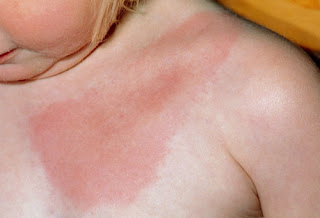
Picture 21: lyme disease due to the tick byte.
image soource: webmd.com
- Kawasaki disease – believed to have been caused by an autoimmune response.
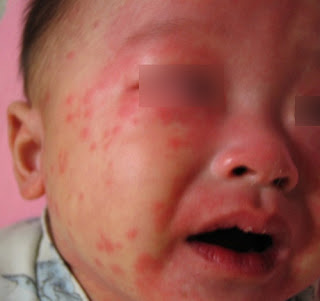 Picture 22: Kawasaki disease rash is one of the rash along with the fever.image source: intechopen.com
Picture 22: Kawasaki disease rash is one of the rash along with the fever.image source: intechopen.com
- Toxic Shock Syndrome – a life-threatening disease affecting the many body systems.
 Picture 23: This rash is one of the symptom to toxic shock syndrome.image source: syndromespedia.com
Picture 23: This rash is one of the symptom to toxic shock syndrome.image source: syndromespedia.com
Causes of Rashes in Children
The causes of rashes in children can be varied. The common causes of rashes are due to some virus, bacteria, fungus, allergic reactions to certain food and medication, and heat exposure.
Symptoms of Rashes in Children
Chickenpox
- Fever and sore throat
- Malaise
- Rashes that appear on the head and torso and spread toward the limbs
Regular Measles
- Nasal congestion and cough
- Eye redness
- Moderate fever
- Loss of appetite
- Decreased level of activity
- Brown rash on the face extending to the hairline and behind the ears. Eventually, rashes will spread to the thighs and feet
Picture 25: Brown rashes all over the body caused due to the regular measles.
image source: outbreaknewstoday.com
image source: outbreaknewstoday.com
German Measles
- Mild sore throat
- Moderate fever
- Headache
- Stomachache
- Swollen lymph nodes in the neck
- Red rough rashes develop
- Flushed cheek
- Perianal or vaginal strep infection that are associated with redness, itchiness, and pain
Picture 26: Red rough rash on the body caused due to the German measles.
image source: slideplayer.com
image source: slideplayer.com
Fifth Disease
- Nasal congestion
- Cough
- Headache
- Mild sore throat
- Low-grade fever
- Rashes appear when the child is no longer contagious—when the symptoms of viral illness are over
- “Slapped cheek” appearance
picture 27: rashes on cheeks looks alike "slapped cheek" and lacy look on rashes due to fifth disease.
image source: www.flspinalcord.us
image source: www.flspinalcord.us
Roseola Infantum
- Abrupt onset of high fever
- Appearance of small, pink, flat or slightly elevated rashes on the trunk and extremities
Coxsackieviruses and Other Enteroviruses
- Fever
- Tender blisters in the mouth and tongue, palms, and soles
- Rashes may also develop either in the buttocks or in the genital area
- Malaise
picture 29: Rashes and blisters and inside of mouth and on the tounge caused by coxsackieviruses and other enteroviruses.
image source: diseasespictures.com
image source: diseasespictures.com
Impetigo
- Small blister in the skin surface that breaks and leaves the skin red and open
- Honey-colored crust develop over the rash
- Itchiness.
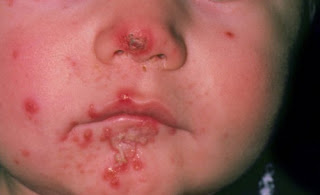
Picture 30: blisters of honey coloured around the mouth and nose.
image source: nhs.uk
image source: nhs.uk
Diagnosis of Rashes in Children
Rashes that can be seen in children are not really a cause of an emergency situation but merit a visit to the pediatrician for proper checkup. Here’s a simple way to examine the rashes before getting too worried.
- Check the rash and determine whether the rashes are flat or raised. Flat bumps are associated with facial, heat, and contact rashes while raised bumps are commonly due to insect bites and other allergic conditions.
- Examine the shape. Pimple-like rash contain small bumps with a little white head in the middle. Contact rashes may contain a group of small pimples. Lacy are like markings of a lace on a person’s skin. Ring-shaped rashes might be indicative of a ring worm.
- Ask of the rashes are itchy. Common rashes that are itchy are caused by contact rashes, eczema, insect bites, and hives.
- Observer other symptoms. If symptoms are quite systemic and may include fever, malaise, loss of appetite, etc, it is recommended to seek medical attention as soon as possible.
Treatment
Chickenpox
- Medications will be prescribed by the physician
- Never give aspirin as this is associated with Rye syndrome
Measles
- Medications to treat cough, eye symptoms, and fever
- Do not use aspirin medications
- Antibiotics
- Follow needed vaccination to prevent measles
German Measles
- Effective vaccination
- Childbearing women should have their immune system verified and stabilized
Scarlet Fever
- Antibiotics
- Seek doctor’s help as soon as possible
Roseola Infantum
- Acetaminophen for fever
- Avoid aspirin
- The disease is not harmful and gets better without specific therapy
Coxsackieviruses and other enteroviruses
- Fever can be managed by acetaminophen or ibuprofen
- Avoid aspirin products
- Observe proper hand washing
Impetigo
- Topical or oral antibiotics
- If symptoms persists, have the child checked by the physician
For rashes that typically result to high fever, such as Lyme disease, Kawasaki syndrome, etc., it is always recommended to seek medical attention as soon as possible for prompt management of symptoms.





